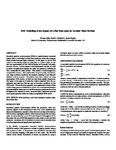SPH Modelling of the Impact of a Flat Plate upon an Aerated Water Surface
| dc.contributor.author | Sdiq, H | |
| dc.contributor.author | Graham, David | |
| dc.contributor.author | Hughes, Jason | |
| dc.date.accessioned | 2017-06-20T16:28:32Z | |
| dc.date.available | 2017-06-20T16:28:32Z | |
| dc.date.issued | 2017-06-25 | |
| dc.identifier.isbn | 9781880653975 | |
| dc.identifier.issn | 1098-6189 | |
| dc.identifier.issn | 1555-1792 | |
| dc.identifier.uri | http://hdl.handle.net/10026.1/9503 | |
| dc.description.abstract |
Smoothed particle hydrodynamics (SPH) is a particle-based numerical method that is well-suited to fluid flow problems where the computational domain becomes highly deformed. In this paper we use an SPH method to simulate the impact of a flat plate on a water surface, as carried out experimentally in the FROTH project at Plymouth University, Ma et al. (2016). A novel feature of the experiments was that, in order to mimic wave/structure impacts, the water was aerated by bubbling air from underneath the water surface. This created a non-homogeneous, compressible mixture. This implies that, for good quality simulations, very large numbers of particles are required, meaning in turn that parallelised code is required. Simulations have been carried out using single-phase SPH models, in both two and three spatial dimensions. The speed of the plate as it enters the water is specified from the experiments and data from this are used as boundary conditions for the SPH model. The results show generally good agreement in terms of free surface shape, pressure distributions, sound wave developments/reaction and pressure/time traces, but we note that maximum pressures as well as propagation and reaction of sound waves are highly dependent upon the sound speed specified within the weakly-compressible SPH model. | |
| dc.format.extent | 596-603 | |
| dc.language.iso | en | |
| dc.title | SPH Modelling of the Impact of a Flat Plate upon an Aerated Water Surface | |
| dc.type | conference | |
| dc.type | Conference Proceeding | |
| plymouth.date-start | 2017-06-25 | |
| plymouth.date-finish | 2017-06-30 | |
| plymouth.conference-name | International Society of Offshore & Polar Engineers, 2017 | |
| plymouth.publication-status | Published | |
| plymouth.journal | International Society of Offshore & Polar Engineers, San Francisco, 2017 | |
| plymouth.organisational-group | /Plymouth | |
| plymouth.organisational-group | /Plymouth/Faculty of Science and Engineering | |
| plymouth.organisational-group | /Plymouth/REF 2021 Researchers by UoA | |
| plymouth.organisational-group | /Plymouth/REF 2021 Researchers by UoA/EXTENDED UoA 10 - Mathematical Sciences | |
| plymouth.organisational-group | /Plymouth/REF 2021 Researchers by UoA/EXTENDED UoA 10 - Mathematical Sciences/UoA 10 - Former and non-independent | |
| plymouth.organisational-group | /Plymouth/REF 2021 Researchers by UoA/UoA10 Mathematical Sciences | |
| plymouth.organisational-group | /Plymouth/Research Groups | |
| plymouth.organisational-group | /Plymouth/Research Groups/Marine Institute | |
| plymouth.organisational-group | /Plymouth/Users by role | |
| plymouth.organisational-group | /Plymouth/Users by role/Academics | |
| dc.publisher.place | San Francisco | |
| dcterms.dateAccepted | 2017-04-10 | |
| dc.identifier.eissn | 1555-1792 | |
| dc.rights.embargoperiod | Not known | |
| rioxxterms.licenseref.uri | http://www.rioxx.net/licenses/all-rights-reserved | |
| rioxxterms.licenseref.startdate | 2017-06-25 | |
| rioxxterms.type | Conference Paper/Proceeding/Abstract |


